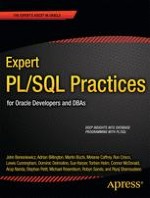Expert PL/SQL Practices is a book of collected wisdom on PL/SQL programming from some of the best and the brightest in the field. Each chapter is a deep-dive into a specific problem, technology, or feature set that you’ll face as a PL/SQL programmer. Each author has chosen their topic out of the strong belief that what they share can make a positive difference in the quality and scalability of code that you write.
The path to mastery begins with syntax and the mechanics of writing statements to make things happen. If you’ve reached that point with PL/SQL, then let the authors of Expert PL/SQL Practices show you how to combine syntax and mechanics with features and techniques to really make the language sing. You’ll learn to do more with less effort, to write code that scales and performs well, and to eliminate and avoid defects.
These authors are passionate about PL/SQL and the power it places at your disposal. They want you to succeed, to know all that PL/SQL can offer. Let Expert PL/SQL Practices open your eyes to the full power of Oracle’s world-class language for the database engine.
Goes beyond the manual to cover good techniques and best practices Delivers knowledge usually gained only by hard experience Covers the functionality that distinguishes PL/SQL as a powerful and scalable programming language for deploying logic inside the database engine
